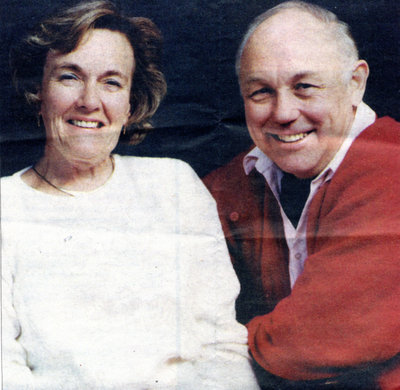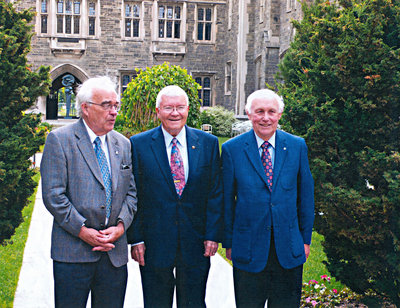Updated and expanded version of an article originally by David Lea, Oakville Beaver – July 18, 2007

He has helped astronauts in distress, helped NASA gain a better understanding of Mars, made revolutionary contributions to the field of diamond exploration and, at 75, is showing no signs of calling it quits. John Barry French, Oakville resident and professor at the University of Toronto's Institute for Aerospace Studies, has spent his adult life making scientific accomplishments that have not only helped seal Canada's position as a technological innovator, but changed the world itself. In late June, French's country recognized him for these contributions, appointing him a Member of the Order of Canada.
"It's marvelous, I can't really believe it," said French. "It's very nice when people appreciate the things you've been doing. I've always concentrated on trying to help Canada."
The rank of Member in Canada's highest civilian award is reserved for those who have undertaken a lifetime of distinguished service in or to a particular community, group or field and truly Ottawa would have been hard pressed to locate a scientist with a more astounding career.
Born in Mimico on Aug. 22, 1931, French was the son of a commercial artist, but early on decided to walk the path of science and graduated with an honours in chemical engineering from the University of Toronto in 1955.
A Masters in Science from the Graduate School of Thermodynamics and related studies in Birmingham, England followed in 1957, as did a Ph.D. from the Institute for Aerospace Studies at the University of Toronto in 1962.
Just six years later, French's expertise had elevated him to the presidency of Aerospace Engineering and Research Consultants Ltd., a consulting organization composed of staff members from the University of Toronto's Institute for Aerospace Studies. It was here that French had his first brush with history.
In 1970 during the famed Apollo 13 manned lunar landing mission, an oxygen tank on the Odyssey spacecraft exploded leaving it crippled and placing its crew in serious jeopardy. "Some of my colleagues and I were phoned by NASA, actually by Martin Marietta, the builder of the lunar capsule, and they wanted advice," said French. "The lunar excursion module was their life boat. It had the life support stuff in it that allowed them to breathe and have a little bit of battery power, but near the end of the flight back to Earth, they had to separate the re-entry component from this lunar module in a way that wasn't planned for."
The plan called for the detonation of a prima cord explosive ring connecting the two spacecraft components, but there was concern about the amount of air present in a tunnel the astronauts used to move between them.
"The idea was to leave the air in there, so that when they cut the things in two the air would separate the two pieces because you have to get them clear of each other. The problem was, if they left too much air pressure in there, the explosion from the prima cord might have damaged the entry hatch and, if they left too little air in there, there would not be enough of a force to separate them," said French.
So, the question was what pressure of air to leave and we had two hours to calculate, as best we could, what the best choice for air pressure was." After much deliberation French's team came up with about three pounds per square inch as the ideal air pressure for the situation, which they relayed to NASA.
Although they did not know at the time, NASA later confirmed that their recommended pressure had been used to achieve the successful separation and subsequent safe re-entry of the landing capsule.
“That was an exciting day” said French. Forty years later it was commemorated by a Space Pioneer award from the Canadian Air and Space museum, where French met one of the astronauts the Toronto group had helped to save, Fred Haise, who was the Apollo 13 Lunar Module Pilot. His letter states-
“Let me join others in congratulations to the University of Toronto Institute of Aerospace Studies as the recipient of this years Air & Space Pioneer Award. As the Lunar Module Pilot on Apollo 13 I would certainly vouch for their credentials. Their study and calculations provided a safe means to utilize pressure in the tunnel area between the Command & Service Module (CSM) and the Lunar Module (LM) to assure safe separation of the LM without damaging the hatch. This was another one of the new procedures that had to be implemented on Apollo 13 to assure our safe return. My sincere thanks and congratulations again on your well deserved award!”
Fred Haise
Apollo 13 Lunar Module Pilot
French's contributions to Canada and the world continued in 1974 with his co-founding of Sciex Ltd., a Canadian instrumentation manufacturer formed to develop and market trace gas instruments. "Our equipment is very useful for airborne monitoring and water monitoring for trace pollutants and we were involved in a number of incidents that dealt with real time monitoring," said French.
These incidents included the ecological disaster in the American neighbourhood known as Love Canal in 1979 and the Mississauga train wreck of 1979 in which a train carrying poisonous and explosive chemicals derailed resulting in the evacuation of 250,000 residents. "We were the guys that were monitoring downstream to see where the chlorine went," said French.
In the days following the train derailment, clean-up crews began experiencing intense eye, nose and throat irritations and it was scientists from MDS Sciex, who discovered that chlorine leaking from the train tankers had combined with leaking styrene to produce mace. Based on this information, public officials intensified their efforts to contain the disaster and residents returned safely to their homes within a few days.
Sciex equipment has also been used for the detection of narcotics, explosives and alcohol in cargo containers during trans-shipment at ports in Japan, the Middle East, Europe and the United States.
However, when Sciex modified its mass spectrometers so that they could detect and identify trace organic molecules in liquids (such as blood) they became a major equipment supplier to the bio industries world wide, particularly the pharmaceutical companies, who could now rapidly measure variations in drug metabolic pathways in drug screening trials.
French's accomplishments in the technological field did not limit themselves to the Earth, but stretched all the way to Mars with the 1975 launch of NASA's Viking Space Probes. In his laboratory at UTIAS, French had developed the only facility in the world capable of simulating the hypersonic entry of Viking through the Martian atmosphere. The NASA Martian entry mass spectrometer was refined and its response calibrated so that it could provide the first accurate data on the components of the Martian atmosphere. This was actually the first Canadian contribution to Martian exploration.
This provided planetary researchers with incalculably valuable data about the planet and why it is so different from Earth. "Mars has no magnetic field and because of that it has no shielding from the solar winds that stream out from the sun," said French. "We have a magnetic field that protects us, the solar winds stream out around us, it doesn't hit our atmosphere, but it does on Mars. What you have is a winnowing like when you throw up wheat. The wind blows the light stuff away and that's what it did with the Martian atmosphere. Over the ages it was stripping away everything. So, from these measurements they got the first indication that we're lucky to have life on Earth because we have a magnetic field to shield us."
As if all these achievements and adventures were not enough for one lifetime, in 1996, French went on to co-found GEDEX, a company now involved in developing cutting-edge earth imaging technology. One particular project has such strong applications in the field of diamond exploration that the South African company De Beers, the world's largest diamond mining group, has joined with GEDEX to pursue its development.
The project involves the employment of the airborne gravity gradiometer, a device that detects gravity shifts, which allows researchers to get an idea of what is beneath the Earth's surface. "If you have 100 square kilometers, you fly over in a pattern and you get enough data from that to unscramble the mass that's down below, you can begin to see a picture of the gravity highs and lows and where they are and how deep they are. So you can map out things like kimberlite pipes," said French.
Finding geographic features like kimberlite pipes are important because where they are found, diamonds are found, and by surveying an area with a plane more kimberlite pipes can be found faster. "You could do this on the ground if you slowly moved around, putting the instrument down, taking your measurements and moving again, but there are literally hundreds of thousands of square kilometers. A third of the Canadian Arctic is staked and claimed for diamonds," said French. "There is a vast amount of territory to be surveyed and we and De Beers think this is the best way to do it"
Getting the gravity gradiometer to work in an airplane was no easy task requiring great innovation on the part of GEDEX. "We basically took the instruments, which were developed in the U.S. and Australia, licensed them and we took Canadian technology from the space program," said French. French and his colleagues adapted an isolation system, used to keep components stable in space, to work in an aircraft environment. The end result was a device that is now poised to revolutionize subterranean resource exploration.
With leading roles in so many groundbreaking projects, it was only a matter of time before Canada presented French with the Order of Canada, the ultimate lifetime achievement award. However, French is adamant he is a victim of circumstance. "I've been lucky to work with wonderful people," he said. "Also, Canada has been such a great country for us to live in. That's the luckiest draw I've had is to be born in Canada."
French, a husband and father of four, is an experienced sailor recently completing a trans-Atlantic crossing with his wife Gloria. Despite his non-scientific interests he is not sure if retirement is in the cards for him. "I'm a failure at retirement," joked French, as he reflected on the fact that he is still making globe-altering contributions to science 20 years after he intended to give up the game. "As long as I can keep doing this I will.

